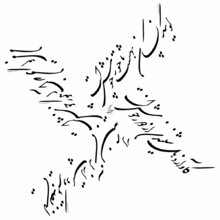Ruba'i

Rubāʿī (Persian: رباعی rubāʿī)[1] is a poem, or verse of a poem, consisting of four lines. It refers specifically to a Persian quatrain, or its derivative form in English and other languages. The plural form of the word, رباعيات rubāʿiyāt, often anglicised as rubaiyat, is used for a collection of such quatrains.[2] There are a number of possible rhyme schemes to the rubaiyat form, e.g. AABA, AAAA.[3] In Persian verse, the ruba'i is usually written as a four-line (or two-couplet) poem, with rhymes at the middle and end of each line.[4][5][6]
An author described;
" basically Ruba'i belongs to Persia and its metres had been created by a non-Arab poet Abul Hassan Rodeki and that was also brought into practice by non-Arab and Urdu poets. Ruba'i (quatrain) has special metres containing 24 categories (one can say "divisions" or "branches" too). Ruba'i can only be composed in those special metres, not any other normal meter. Ruba'i consists of only four lines, its two lines called 'Sehr' (Stanza). Ruba'i's first and second line must end in rhyme (example-as behold and cold.), third without rhyme, but within 24 special metres, that cannot be changed and fourth line again in the selected rhyme, but that fourth line (misra) contains high, strong and complete and deep meanings, that must be related with above three lines. These should be addressed only one point or subject, not as like ghazals or other forms of the poetry have."[7]
This is an example of a ruba'i from Rūmī's Dīwān-i Shams.
- Anwār-i Ṣalāḥu'd-Dīn bar angēkhta bād
- Dar dīda u jān-i ʿāshiqān rēkhta bād
- Har jān ki laṭīf gasht u az luṭf guzasht
- Bā khāk-i Ṣalāḥu'd-Dīn dar āmēkhta bād
- "May the splendors of Salahuddin be roused,
- And poured into the eyes and souls of the lovers.
- May every soul that has become refined and has surpassed refinement
- Be mingled with the dust of Salahuddin!"[8]
Ruba'i in English
The verse form AABA as used in English verse is known as the Rubaiyat Quatrain due to its use by Edward FitzGerald in his famous 1859 translation, The Rubaiyat of Omar Khayyam. Algernon Charles Swinburne, one of the first admirers of FitzGerald's translation of Khayyam's medieval Persian verses, was the first to imitate the stanza form, which subsequently became popular and was used widely, as in the case of Robert Frost's 1922 poem "Stopping by Woods on a Snowy Evening".
Fitzgerald's translation became so popular by the turn of the century that hundreds of American humorists wrote parodies using the form and, to varying degrees, the content of his stanzas, including The Rubaiyat of Ohow Dryyam, The Rubaiyat of A Persian Kitten, The Rubaiyat of Omar Cayenne and The Rubaiyat of Omar Khayyam, Jr.
sample: Goblet a Ruba'i of Omar Khayyám translated by Edward FitzGerald:[9]
- At dawn came a calling from the tavern
- Hark drunken mad man of the cavern
- Arise; let us fill with wine one more turn
- Before destiny fills our cup, our urn.
In extended sequences of ruba'i stanzas, the convention is sometimes extended so that the unrhymed line of the current stanza becomes the rhyme for the following stanza.[10] The structure can be made cyclical by linking the unrhymed line of the final stanza back to the first stanza: ZZAZ.[11] These more stringent systems were not, however, used by FitzGerald in his Rubaiyat.
See also
References
- ^ The Persian noun is borrowed from Arabic رباعي rubāʿī "consisting of four, quadripartite, fourfold" whose root consonants ر ب ع (r-b-ʿ) also occur in the numeral أربعة arbaʿah "four". See J.M. Cowan (ed.), The Hans Wehr Dictionary of Modern Written Arabic, fourth edition, Wiesbaden:Harrassowitz, 1994.
- ^ A Brief History of Persian Literature, by the Iran Chamber Society
- ^ Princeton Encyclopedia of Poetry and Poetics, Princeton University Press, 1974, p.611
- ^ Introduction to The Rubaiyat of Omar Khayyam, translated by Peter Avery and John-Heath Stubbs, Penguin Classics, 1981, ISBN 0-14-044384-3, p. 9 [1]
- ^ The Cambridge History of Iran, v. 4, edited by R. N. Frye, Cambridge University Press, 1999, ISBN 0-521-20093-8, pgs. 633-634 [2]
- ^ Elwell-Sutton, L. P. "The Foundations of Persian Prosody and Metrics," Iran, v. 13 (1975), p. 92.
- ^ Dr.Amjad Parvez (25 March 2013). "A splendid poetry collection". Daily Times. Retrieved 11 April 2014.
- ^ "The Splendors of Salahuddin".
- ^ The most famous translation ... 1859 by Edward J. Fitzgerald. okonlife.com
- ^ Skelton, Robin (2002). The Shapes of Our Singing: A Comprehensive Guide to Verse Forms and Metres from Around the World. Spokane, WA: Eastern Washington University Press. p. 106. ISBN 0-910055-76-9.
- ^ Turco, Lewis (2000). The Book of Forms: A Handbook of Poetics. Lebanon, NH: University Press of New England. p. 245. ISBN 1-58465-022-2.
